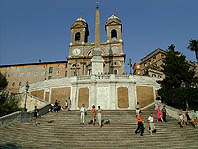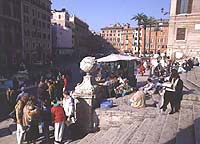Piazza di Spagna
Piazza di Spagna
 In the 18C English milords and their retinue came to Rome in droves, rounding off their formal education with a personal visit to the cradle of Western Civilization. So the less well-off pilgrims were joined by scholars, artists, poets and big spenders from the West.
In the 18C English milords and their retinue came to Rome in droves, rounding off their formal education with a personal visit to the cradle of Western Civilization. So the less well-off pilgrims were joined by scholars, artists, poets and big spenders from the West.
This was then Rome's periphery, just inside Porta Flaminia, the main entry to the city, and thus the obvious spot for their carriages to stop. Fine places to stay and to eat sprang up, many with foreign names that still abound: hotels called Londra, Parigi, Inghilterra, Carriage.
The Ciociaras, girls from nearby hill towns, came to Rome dressed up in their finery and loitered on the Spanish Steps, hoping to catch the eye of a painter looking for a model, or of a rich but lonely foreigner. And then came shops of every kind: stores to provide these newfangled "Tour-ists" not only with a way of spending their time and their money, but also with a new commodity: souvenirs and gifts to take home.
Before plunging into the latest version of these shops in the adjacent streets: Via Condotti, Via Frattina, Via della Croce, Via Borgognona, Via del Babuino, etc, let's enjoy the eye-filling beauty of this centuries-old piazza.
Spanish Steps
(Scalinata di Piazza di Spagna). (1723 de Sanctis/A. Specchi). Scalinata Scandal! Despite the name (from the nearby Spanish Embassy) these beautiful stairs were financed by the French ambassador and by King Louis XV.
Louis XIV had wanted to built them (with a vanity statue), but was thwarted by successive Popes. After 150 years the project had become a "Cause Celebre".
|
Scalinata
History 
1564. Giacomo della Porta was the first architect to come up with a design. 1578. The hill, a private vineyard, was expropriated by Pope Gregory XIII to make room for the staircase. But French ambition postponed it repeatedly. 1600. The hill had a double line of shade trees. Three Popes squabbled with the French kings. Prime Ministers Colbert and Cardinal Mazzarin vehemently pushed for a solution, championing the Convent of the Minim's wish for all-weather access (the hill became a mud-slide in Winter). Mazzarin offered to pay on condition that there be a statue of the French King. The Pope refused. 1707. First one, then another competition was held for the stair architecture. The two winners finally compromised on the design you see today.The architectural feature of this sweeping Baroque river of stairs is that it is not - as it seems - symmetrical since the Church at the top does not directly face the Square below. |
Obelisk
(Obelisco) (1C BC). From the gardens of Julius Caesar's colleague Sallust (Sallustio's Orchard).
A Roman copy of the Egyptian obelisk now in nearby Piazza del Popolo. The ancient Romans loved Egyptian culture and copied it slavishly. So there were 48 obelisks in ancient Rome, many of which have been placed by subsequent Popes in front of Churches of particular importance.